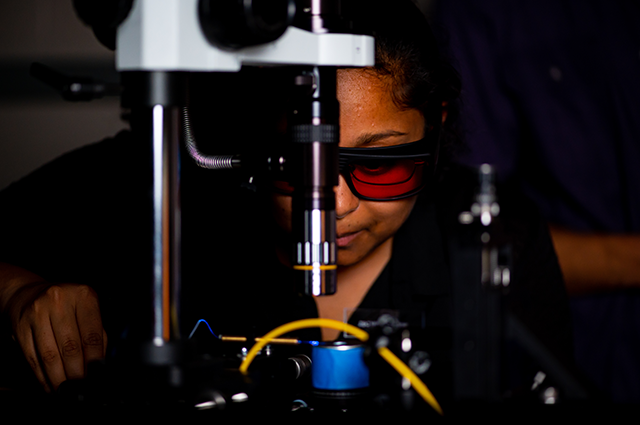Optical quantum information systems

Aseema Mohanty, Clare Boothe Luce Assistant Professor in the Department of Electrical and Computer Engineering, has been working on quantum information systems-related projects since her graduate student research years. Now teaching and researching at Tufts University, she continues her work in this area as principal investigator of the Mohanty Nanophotonics Lab. Her studies focus on the use of nanophotonics and engineered light-matter interactions to control, shape, and sense light, which can be used to develop high-performance optical circuits at the material, device, and system levels.
Mohanty’s latest project is developing a high-performance visible photonic platform for the manipulation of large-scale quantum emitter arrays. While quantum information systems offer a new world of possibilities in the secure transfer of information and in solving previously-intractable problems, challenges remain in order to implement these systems practically. One of those challenges is manipulating large-scale quantum emitter arrays for reconfigurable entanglement states in a compact form factor. With recent grant funding from the US Air Force Office of Scientific Research (AFOSR), Mohanty proposes to build a platform using aluminum nitride and silicon nitride, leveraging the high-speed modulation properties of aluminum nitride and the low losses of silicon nitride waveguides.
When it comes to quantum information systems, Mohanty says, chip-scale optical circuits and devices could make the commercial implementation of quantum optical systems possible. “Optical quantum information systems in particular require coherent control over a large number of single-photon sources and optical channels,” she says – which leads researchers to miniaturizing large table-top systems to the chip scale.
Nanophotonics devices enable control of the flow of light with extreme precision and scalability on a chip, and Mohanty’s work as a whole offers promising potential for optimizing chip-scale optical devices. These devices have applications in implantable and wearable biomedical devices, neuroscience, AR/VR displays, emerging computing and communications systems, and beyond.
Learn more about Professor Mohanty and the Nanophotonics Lab.
Department:
Electrical and Computer Engineering